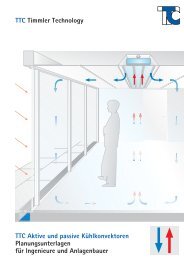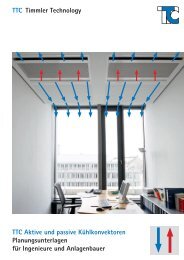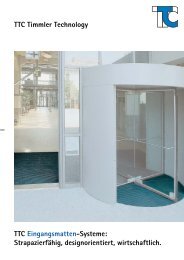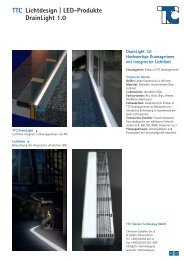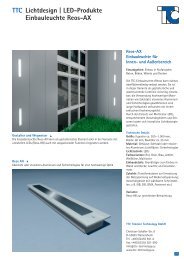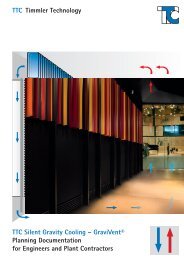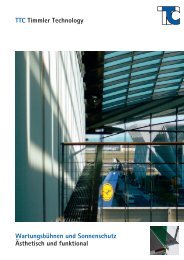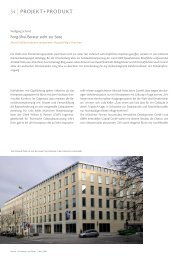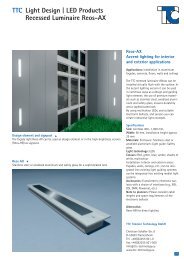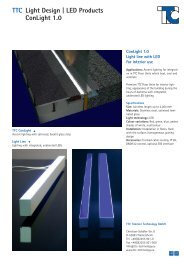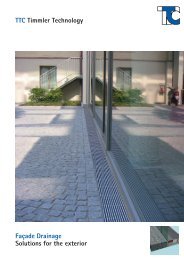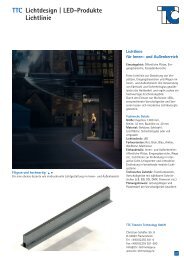TTC Timmler Technology TTC Active and Passive Chilled Beams ...
TTC Timmler Technology TTC Active and Passive Chilled Beams ...
TTC Timmler Technology TTC Active and Passive Chilled Beams ...
You also want an ePaper? Increase the reach of your titles
YUMPU automatically turns print PDFs into web optimized ePapers that Google loves.
Design Example<br />
<strong>Passive</strong> <strong>Chilled</strong> Beam | Example model AECBU<br />
28<br />
Other calculation criteria ><br />
Calculate ∆m ><br />
Calculate q · K(spezif.) ><br />
Required finned length L(finned) ><br />
Required finned length L(finned) ><br />
Unit width B 45 cm ><br />
Unit width B 60 cm ><br />
Select a chilled beam ><br />
Water volume flow m · W ><br />
Calculate ∆p · W(specif) ><br />
Total water-sided pressure drop ><br />
Cooling power of the primary air ><br />
The Task<br />
An office with a sensible cooling load of Q · K(sen) = 1.200 W is to be cooled using two passive<br />
chilled beams of the type AECBU. In addition, preconditioned primary air will be fed<br />
into the room.<br />
The chilled beams are to be installed in a panelled ceiling at a height of 2,7 m.<br />
The required supply air flow will be supplied to the room through a ventilation system.<br />
The room volume is approx. 80 m³.<br />
· Cold water temperatures: tW1<br />
= 17°C <strong>and</strong> tW2 = 19°C<br />
· Room temperature: tR<br />
= 26°C<br />
· Supply air temperature: tL(ZU)<br />
= 18°C<br />
· Max. possible installation length L(tot)<br />
= 5,50 m<br />
· The supply air flow V·<br />
L(ZU) shall be 240 m³/h, i.e. the air in the room is to be changed 3 times<br />
· Cooling capacity Q<br />
·<br />
K(sen) = 600 W per chilled beam<br />
The Solution (explained step by step)<br />
1. Use Formula 1 to calculate the average temperature difference ∆m<br />
(tW1 + tW2)°C<br />
∆m[K] = tR - = 26 -<br />
2<br />
2. Fig. 24.4 gives the following specific cooling capacity qK(specif.) for unit width of 45 <strong>and</strong><br />
60 at ∆m = 8 K:<br />
· (Unit width 45) q·<br />
K(specif) = 180 W/m<br />
· (Unit width 60) q·<br />
K(specif) = 270 W/m } Note! For people to feel comfortable a specific cooling power of<br />
250 W/m should not be exceeded in rooms used as offices.<br />
3. Calculate the required finned length of the chilled beams<br />
· a) (Unit width 45) L(finned)<br />
= Q · K(sen)[W]: q · K(specif)[W/m] = 600 W : 180 W/m ≈ 3,33 m<br />
· b) (Unit width 60) L(finned)<br />
= Q · K(sen)[W]: q · K(specif)[W/m] = 600 W : 270 W/m ≈ 2,22 m<br />
Deduction in line with Fig. 24.3:<br />
· for a) part no. AECBU3545, unit length L(tot.)<br />
= 35 dm > equivalent to L(finned) = 3,3 dm<br />
· for b) part no. AECBU2560, unit length L(tot.)<br />
= 25 dm > equivalent to L(finned) = 2,3 dm<br />
4. Select the chilled beam you require from step 3.<br />
In respect of the installation length you could use both of the chilled beams. For the<br />
subsequent calculation we have chosen solution »b« (part no. AECBU2560 _ _ _ OS)<br />
Installed cooling capacity Q · K(sen) = 270 W/m · 2,3 m = 621 W (required 600 W)<br />
Water-sided pressure drop<br />
5. Rough calculation of the water volume flow using formula 4<br />
m˙ W[kg/h] = 860 ·<br />
17°C + 19°C<br />
2<br />
q˙ (spezif) [kW/m] · L(finned)[m]<br />
tW2 - tW1 [K]<br />
6. Calculate the total water-sided pressure drop using formula 5<br />
· Fig. 24.5 shows a specific pressure drop of ∆pW(specif) = 1,9 kPa/m for mW = 267 kg/h<br />
· The selected chilled beam AECBU 2560 has a finned length of L(finned)<br />
= 33 dm = 3,3 m<br />
∆pW(tot)[kPa] = ∆pW(spezif)[kPa/m] · L(finned)[m] = 1,9 kPa/m · 2,3 m = 4,37 kPa<br />
Air-sided cooling capacity<br />
7. The additional cooling capacity provided through the required supply air supply at<br />
240 m³/h is calculated as follows:<br />
Please note > Note!<br />
Corrective factors must be applied to the calculated cooling power if <strong>TTC</strong> grills are used<br />
for air inlet <strong>and</strong> air discharge (please refer to the <strong>TTC</strong> Modultherm Planning Documentation)<br />
= 8 K<br />
0,27 kW/m · 2,3 m<br />
= 860 · = 267 kg/h<br />
2 K<br />
240 (m³/h) · 1,2 (kg/m³) · 1 (kJ/kg·K) · 8 (K)<br />
Q<br />
3600<br />
· K(air)[kW] = = 0,64 kW<br />
Subject to technical changes · Issued 10/2010



